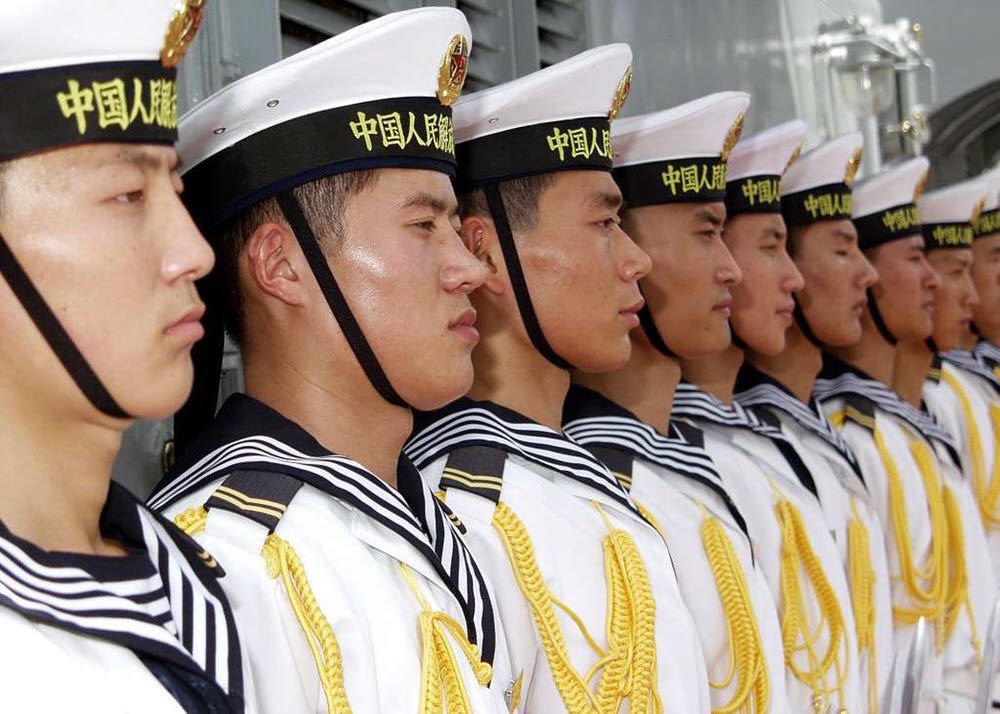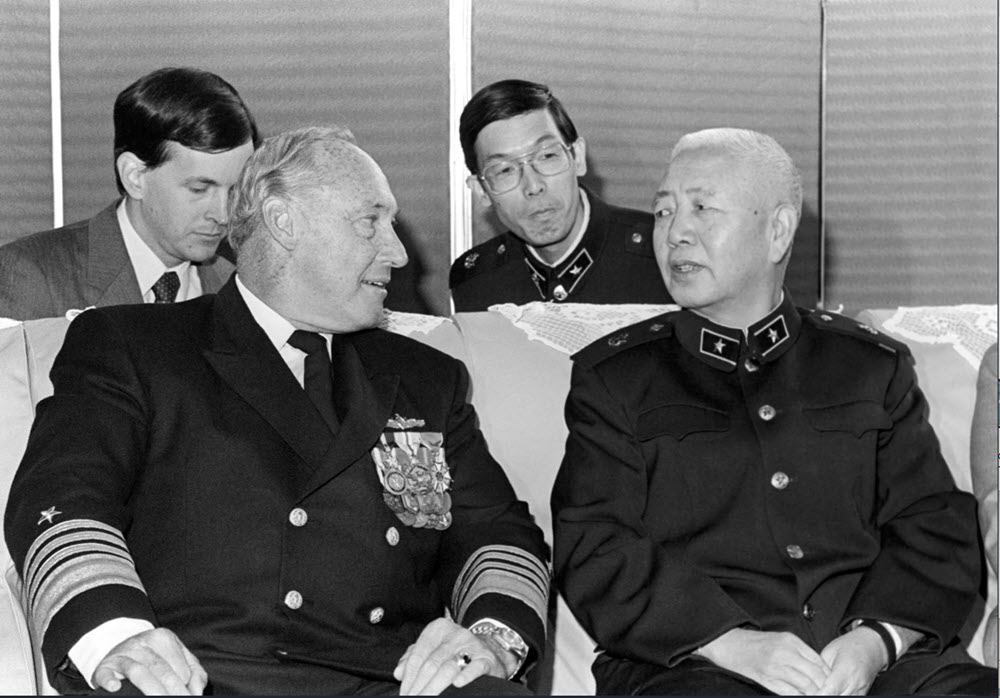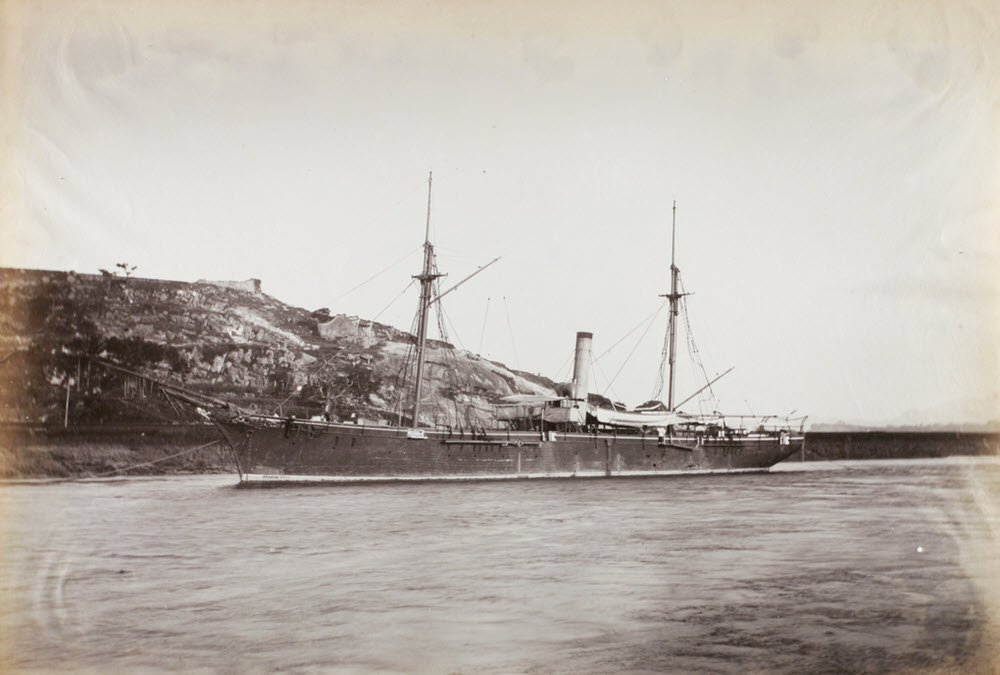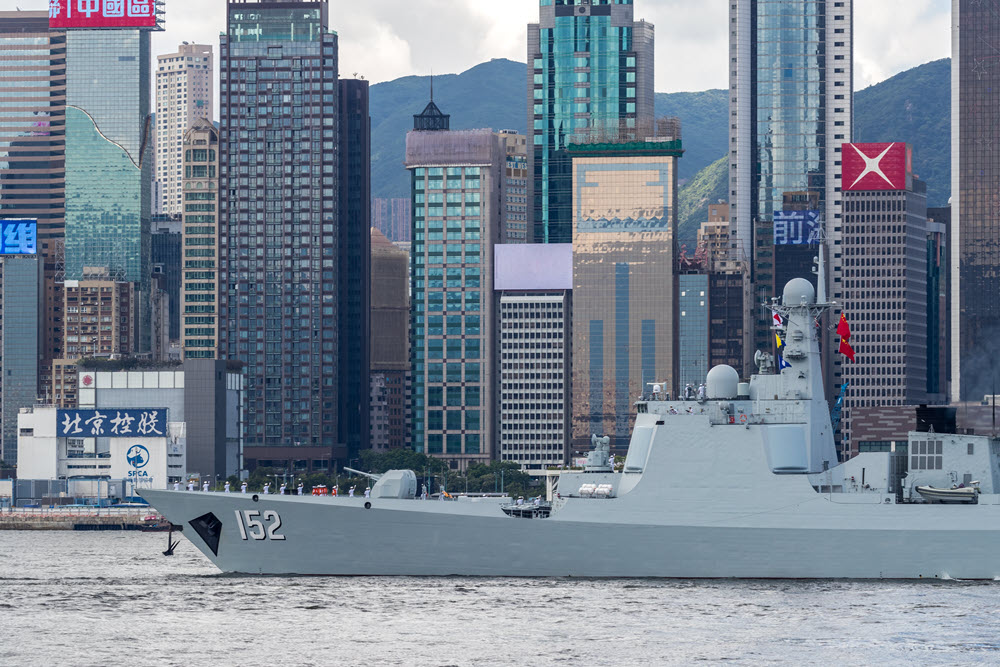The People’s Republic of China (PRC) has significantly modernized and expanded its naval capabilities, reshaping the maritime balance of power in the Indo-Pacific region. To shed light on the evolution and implications of the PRC’s naval strategy, Nai-Yu Chen and Jeremy Rausch interviewed Bernard D. Cole about the driving forces behind the transformation of the People’s Liberation Army (PLA) Navy, its current concepts and objectives, and its future trajectory.
What were the original tenets of the PLA Navy’s role in the PRC’s military strategy, and how have these evolved over the ensuing 70 years?
When the PLA Navy was established in 1927, its only stipulated mission was to “carry out the political tasks of the [Chinese] revolution.” By 1982, its focus had shifted to “resist invasions and defend the homeland,” particularly along the coast. This coastal emphasis on supporting the army and operating in “near sea waters” formally changed only in 2004 under Hu Jintao, a shift that I discussed in both editions of my book The Great Wall at Sea.
China has long had a history of deploying strong naval forces, but on an ad hoc basis. An example is the fourteenth-century “Lakes Campaign.” As Edward Dreyer describes in his chapter for Chinese Ways in Warfare, this campaign occurred primarily on Lake Poyang, the largest freshwater lake in China. This was the scene of a large battle between ships of competing factions of the rebellion movement that was fighting to overthrow the Yuan Dynasty. The smaller Ming fleet led by Zhu Yuanzhang used cannon and fire ships to score a victory.

The PLA won the 1927–49 civil war, and during this period the PLA Navy’s sole mission was to support army operational and logistical efforts on rivers, lakes, and, to a limited extent, coastal waters. This began to change significantly with the army’s failed assault on Kinmen Islands in the fall of 1949, which was a disorganized operation launched against the Republic of China (ROC) forces without command of the sea or the air, resulting in over five thousand PLA casualties. The PLA learned rapidly from this failure, and by the time it assaulted Hainan in early 1950, it had begun the process of developing into a modern (i.e., post-1600) maritime force. The Hainan assault was launched by carefully trained troops operating with PLA control of the sea and of the air. However, the success was due in part to the ROC commanders on the island largely abandoning their troops and fleeing to Taiwan.
Since these early 1950s operations, the growth and modernization of the PLA Navy were extremely episodic until the end of Maoist rule. Despite Mao’s call for a modern navy, he failed to launch programs to achieve that goal. His efforts to develop a seaborne nuclear force, for instance, were a failure largely because considerations of political reliability outweighed those of professional competence.
The PLA Navy played no significant role in the Korean War or the Vietnam conflicts with France and the United States. Furthermore, before the 1980s, it was routinely led by career army officers chosen for their political reliability rather than naval expertise or experience. The first notable commander, Liu Huaqing, was initially a career army officer when appointed to head the PLA Navy in 1982. He immediately began campaigns to modernize and expand the navy, with an emphasis on building indigenous ship construction capabilities and developing professional officers. These campaigns grew and were fruitful, due to both the availability of funding and Deng Xiaoping’s emphasis on modernization. Milestones included establishing a domestic industrial base and concomitantly reduced reliance on foreign warship construction. Purchases from the Soviet Union and later Russia picked up in the 1990s to a limited extent and are early evidence of the PLA’s reliance on reverse engineering of systems and platforms.

As China grew wealthier, so did its defense spending. The army dominated but the air force and navy also benefited from increased resources and the direction of national defense efforts. The navy particularly benefited from initiatives aimed at retaining and “regaining” disputed maritime territories, ranging from Taiwan to Ieodo/Suyan. The improved PLA Navy supported the notably aggressive Chinese efforts to resolve maritime disputes in the Yellow, East, and South China Seas, efforts that continue to this day.
As evidenced in Michael A. McDevitt’s book China as a 21st Century Naval Power, China now deploys the world’s largest navy by the number of ships, with over five hundred seagoing vessels, of which more than two hundred are modern warships. The United States is the only substantial challenger at sea. When factoring in its enormous “civilian” merchant and fishing fleets, China today is the world’s strongest maritime force.
How significant was Hu Jintao’s 2004 “new historic missions” for the PLA Navy’s rethinking of its missions. In what ways did these missions inform and shape the debate about reorienting China’s strategic focus from a continental-based defense to a more maritime-oriented posture?
Hu’s “new historic missions” were very significant. They not only formalized the navy’s role beyond supporting the army but also expanded its operations beyond coastal (“near sea”) realms. This redefinition effectively justified naval engagement in “distant sea” missions and, concurrently, warranted an increase in the allocation of national resources to the PLA Navy. I recommend reading Daniel M. Hartnett’s chapter in Assessing the People’s Liberation Army in the Hu Jintao Era.
In 1995, Jiang Zemin described China as “a continental power, and a coastal power as well.” By 2004, Hu, in a December meeting of the Central Military Commission (CMC), delineated the “Historic Missions of the Armed Forces in the New Period of the New Century.” During this meeting, the PLA Navy commander was made a member of the CMC, a first since Liu Huaqing. The subsequently issued defense white paper for 2004 stated that “the PLA Navy is responsible for safeguarding China’s maritime security and maintaining the sovereignty of its territorial seas along with its maritime rights and interests.” The white paper emphasized the importance of offshore operations, long-range precision-strike capability, joint exercises, and integrated maritime support capabilities.
Hu’s emphasis on securing China’s territorial claims was not new, as similar statements had been made by every Chinese leader since Mao. However, his direction led to a continuing and intensified focus on maritime claims in the Yellow, East, and South China Seas, with additional claims filed with the United Nations on Indian Ocean seabed resources. In the civilian sector, China’s merchant fleet modernized and expanded, earning it the top world ranking in most categories.
Who were the main actors driving the navy’s modernization and expansion, as well as its increasingly central role in PRC military and defense strategy?
Liu Huaqing stands out as the primary mover, as was evident in his description in the late 1980s of three-phased PLA Navy expansion. While every leader since Mao has made statements emphasizing the importance of China possessing a capable navy, progress was slow to develop as the leadership had higher-priority concerns. These encompassed both foreign issues, such as the Korean and Vietnam Wars, and domestic challenges, such as land reform, the Great Leap Forward, the Cultural Revolution, leadership succession, and economic development.
Two other Chinese admirals who were major drivers of naval modernization are often overlooked. Admiral Zhang Dingfa took command after the 2003 loss of a Ming-class submarine and its entire crew, attributed to poor maintenance, supply, and training. This incident led to the firing of the entire chain-of-command responsible for submarine maintenance and operations. Zhang, and especially his successor Admiral Wu Shengli, who served as commander of the PLA Navy from 2006 to 2017, drove the reorganization of these programs and processes, which was a vital step in naval modernization.
Could you elaborate on the PLA Navy’s basic operational concepts, such as “near seas defense,” “far seas protection,” and “active defense”? What were the driving factors for the development and implementation of these concepts, and how have they been implemented?
These active concepts are inherent in the succession of the Outline of Military Training and Evaluation issued periodically to guide PLA training. “Near seas defense” includes waters inside the first island chain, with aspiration to extend to the second island chain. Meanwhile, “far seas protection” broadens PLA Navy territorial, economic, and political missions to global waters. The small task forces deployed to the Gulf of Aden, nominally to counter piracy—increasingly a non-threat in those waters—usually continue their deployments to the Mediterranean, Baltic, Atlantic, and even Pacific waters.
“Active defense” entails anticipating an opponent’s strategy and tactics and acting to prevent their effectiveness. One example offered by a PLA officer in the late 1990s posited that during a crisis over Taiwan, if the United States sends aircraft carrier battle groups to defend Taiwan, it will constitute a strategic attack on China. Consequently, it would justify China retaliating against the carriers before they arrived on the scene. This construct was likely influenced by the 1996 Taiwan Strait crisis. For further reading on this concept, see M. Taylor Fravel’s book Active Defense: China’s Military Strategy since 1949.
These concepts revolve around defending China’s maritime territorial and economic claims—most of which date back to the ROC and before—as defined by Beijing. Beyond these, China has broadened “economic” interests to include safeguarding Chinese citizens working overseas, as evidenced in the fifteen years of counterpiracy operations in the Gulf of Aden and surrounding waters. Additionally, noteworthy developments include the creation of the world’s strongest coast guard, a large semi-trained force known as the maritime militia, and the world’s largest fishing fleet.
Liu Huaqing’s three-phase plan for naval growth aimed at dominating waters within the first island chain by 2000 and the second island chain by 2020 and deploying a global navy, to include aircraft carriers, by 2050. While the first two goals were not met by the target dates, they remain relevant benchmarks for evaluating the PLA Navy’s progress.
Much has been written about the PRC’s shipbuilding capacity and the fact that the PLA Navy is the largest navy in the world quantitatively. What are the most remarkable elements of the PLA Navy’s modernization, and how can its success be measured and analyzed today?
China’s shipbuilding industry led the world for millennia, with the first “modern” shipyard initiated in Shanghai as a British venture in the late 19th century. Ironically, the Jiangnan yard, which once constructed river gunboats for the United States in the mid-1920s, is now building the most modern warships for the PLA Navy.

While the PLA Navy currently ranks first in most categories, with South Korea and Japan as its primary competitors (in that order), nothing it has done during modernization is deemed “remarkable.” It has emulated the trajectories of previous large states with growing economies and foreign interests, such as Venice, Spain, Britain, France, Germany, Japan, Russia, the Soviet Union, and the United States.
The “new” PLA Navy is deploying the standard array of warships, from frigates to aircraft carriers. Also significant is the growth and daily utilization of non-naval maritime forces, namely the maritime militia and the coast guard, which are both subject to operational control by the PLA. China has simply made the investments in facilities and personnel to lead the world in both merchant and warship construction, especially in world-leading submarine forces. Most significant has been the transition from foreign to indigenous acquisition of naval platforms—ships, submarines, and aircraft—forming the sinews of maritime power. Additionally, China leads the world in developing and deploying missile forces that are the core of 21st-century naval power.
Despite this success of its shipbuilding industry, maritime analysts offer mixed opinions on China’s ability in 2024 to dominate the seas within the first or second island chains. Achieving these goals requires more than sheer numbers of ships or state-of-the-art technology. Some analysts cite the PLA Navy’s lack of combat experience as a problem, but that factor applies almost equally to U.S., Japanese, Indian, and other naval forces operating in the western Pacific and the Indian Ocean. The key factor highlighted by many (a view that I share) is that while the U.S. Navy has global responsibilities, the PLA Navy is responsible on a daily basis only for the area within the island chains. Hence, in my view, China in 2024 is capable of preventing events from occurring within the first island chain of which it disapproves.
A perennial challenge for the PRC is achieving the delicate balance of competing domestic and global demands. Given this reality, how should we think about the PLA Navy’s future role in a period when China is facing challenges originating both domestically and internationally?
Beijing’s top national security priority is maintaining the Chinese Communist Party in power. Party politics are thus the key factor in Beijing’s decision-making regarding both domestic and foreign issues, thereby shaping the navy’s future.

There is no indication of a significant reduction in defense budget allocations to the PLA Navy. While the impact of the 2015 defense reforms on the priority of services within the PLA is not entirely clear, these reforms did consciously reorder that priority to the benefit of the navy and air force. Another significant factor in those reforms has been the operational assignment of the coast guard and maritime militia to the navy.
Another effective, although indirect, boost to the PLA Navy’s power stems from the now decades-old requirement for certain merchant vessels, such as roll-on/roll-off ships, to adhere to military specifications—for instance, by having decks strong enough to handle armored vehicles. Finally, the increasing use of nominally civilian resources, ranging from IT personnel to shipyards and repair facilities, is an indicator of the modern “people’s war,” in which civil-military resources and policies are intertwined and mutually supporting. These civil-military interactions were present as early as the 2003 exercises.
International issues and foreign affairs will likely continue to be secondary to domestic matters. One possible scenario that would lead to a diminution of the PLA Navy’s resources and capabilities would be a domestic crisis so demanding of government resources that the PLA budget would be dramatically reduced. One such case would be a catastrophic failure of the Three Gorges Dam complex. Otherwise, Chinese maritime power, both commercial and naval, will continue to expand in technology, operational capability, and platform numbers as long as Beijing continues to allocate the required resources to the PLA.
Bernard D. Cole is an expert on Sino-U.S. relations and maritime strategy. He is Professor Emeritus at the U.S. National War College in Washington, D.C., and previously served in the U.S. Navy for 30 years as a surface warfare officer.
This interview was conducted by Nai-Yu Chen and Jeremy Rausch from the Political and Security Affairs group at NBR.
IMAGE CREDITS
Banner illustration by Nate Christenson ©The National Bureau of Asian Research.
Sailors aboard PLA Navy destroyer Qingdao (DDG 113), 2006 | Image courtesy of the U.S. NAVY (navy.mil/).
Admiral (ADM) James A. Lyons Jr. (left), commander in chief, U.S. Pacific Fleet, visiting ADM Liu Huaqing (right), commander in chief of the PLA Navy, in Qingdao, China, 1986 | Image courtesy of the Combined Military Service Digital Photographic Files, the U.S. National Archives (catalog.archives.gov/).
Imperial Chinese Navy armed transport Fupo, Fujian, taken around 1880 | Image courtesy of the School of Oriental and African Studies Archives, London (SOAS reference MS 380 876/1) and Special Collections, University of Bristol Library (www.hpcbristol.net).
Chinese destroyer Jinan (152) passing through the Victoria Harbour in Hong Kong, 2017 (iStock.com/EarnestTse).

